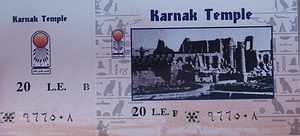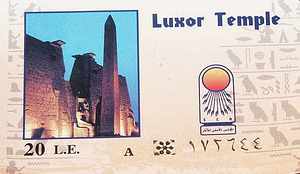Our 3rd Day of Holiday
Karnak and Luxor
Today starts very comfortable. At 7 o'clock is waking. After the breakfast we drive to the largest temple plant of Egypt with the bus to Karnak.  At the entrance again bag control and all of us must by a gate, like at the airport. With everyone it beeps, but that is all. Mad security.
At the entrance again bag control and all of us must by a gate, like at the airport. With everyone it beeps, but that is all. Mad security.
The plant is gigantic! The beginnings of the Amun temple hand back until nearly 2,000 years B.C. and it is actually a temple plant with several temples, which was extended by each Pharaoh with temples for its main God. The temple plant extends over a surface of approximately 101 hectars (1,010,000 square meter). However the columns in the hall of pillars are 25 m high and have an extent of approximately 10 meters. Of that 2. Floor, which is above it, only remainders are to be seen. I must confess completely honestly, I am already completely in disorder, which was now where in which temple. There it is already completely helpful that the camera is with me. Karnak alone were approximately 250 photographs, a small selection see below.
From Karnak we drive to the Isis papyrus museum (again pure selling show). Here we get avowedly, how the old Egyptians manufactured papyrus. Here at the beginning it is still possible to take pictures. The issued pictures may not, one could produce himself similar pictures. Again we cannot resist and acquire a papyrus picture with the tree of life and our names in hieroglyphs written in cartouches.
The tour goes on, after a small break of only 5 Egypt minutes (30 minutes in the material world), while the coffee gossip attendance of the Egyptian president wife from Indonesia drives past. All roads are therefore closed. Well, good luck that we visited the Valley of the Kings yesterday, which the lady wants to visit today.
 To some enormous detours we then nevertheless still come to the temple of Luxor. The temple is located in the middle in the city. One has to imagine that the temple was buried up to the height of the shoulders of the figures at the entrance. Partly some parts of the temple cannot be excavated, because on the debris a mosque was build, which was established as mosque of Abu El Haggag, which is still in operation. It is interesting also that this temple has also a part for Alexander the Great, who was also Pharaoh of Egypt. Here one finds also illustrations of the Egyptian fertility God Min, which Tanja discovered yesterday in the stonecutter workshop completely down in the shelf (or were nevertheless special productions for Beate out...). Explanation: Beate Uhse is the biggest Sex-shop and mail order firm in Germany, located in Flensburg
To some enormous detours we then nevertheless still come to the temple of Luxor. The temple is located in the middle in the city. One has to imagine that the temple was buried up to the height of the shoulders of the figures at the entrance. Partly some parts of the temple cannot be excavated, because on the debris a mosque was build, which was established as mosque of Abu El Haggag, which is still in operation. It is interesting also that this temple has also a part for Alexander the Great, who was also Pharaoh of Egypt. Here one finds also illustrations of the Egyptian fertility God Min, which Tanja discovered yesterday in the stonecutter workshop completely down in the shelf (or were nevertheless special productions for Beate out...). Explanation: Beate Uhse is the biggest Sex-shop and mail order firm in Germany, located in Flensburg
Strangely, the God seems to have a magic effect or at least one part of the body. The density only at this part of the body is already remarkable and can actually come only from continuing stroking. This part of the body is by the way dark at all relief´s so.
Interesting also that in the rear part of the temple a part exists, in which the Egyptian Christians, so-called Copts, had an altar area. The MouseOver gives more explanations to the individual pictures.
The original temple was founded by Amenophis II. (approx. 1,400 BC). Ramses II. put on the today's entrance. In former times there were 2 obelisks at the entrance. The 2nd one is located since 1836 on the Place de la Concorde in Paris.
After the lunch the day is for the free order. Actually we wanted to use the time up to the departure to Edfu (at 19 o'clock or around 23 or around 24, typical Egyptian date) to visit the mummy museum and the Luxormuseum. We remain then on the ship, today it is unbelievably hot. Had instead an intensive nap. At about four thirty we went at deck enjoying the peace again . Pitifully we look on those, which make a trip by a felucca on the Nile. There is no wind and so towards Luxor with the current and back dragged by a motorboat.
At a quarter to seven we have again a wonderful postcard sunset
The evening ends as usual on deck. Writing the diary and of course a few postcards. It is now short to twelve and the boat is still in Luxor. If we disappear not soon to placings, we will go directly into the cab.
Sleep well until tomorrow in Edfu.
September 12, 2002 - Flying to Luxor, our Boat and und Trip by Curricle Through Luxor
September 13, 2002 - Stones, Sand and Grafitti
September 15, 2002 - Edfu, Kom Ombo, Scenery at Nile and Galabeiaparty
September 16, 2002 - Our fifth day - Philae, Assuan, Obelisk, Souk and Nubian Village
September 17, 2002 - Tanjas Birthday, Abu Simbel, Kitchener´s Island
September 18, 2002 - Our seventh day - Traveling back to Luxor
September 19, 2002 - From Luxor to El Gouna
September 20, 2002 - Relaxing in the Hotel
September 21, 2002 - Snorkeling in the Red Sea
September 22, 2002 - Deserttour
September 23, 2002 - The Yellow Submarine
September 24 and 25, 2002 - Our last two days in Egypt
September 26, 2002 - Return journey with obstacles